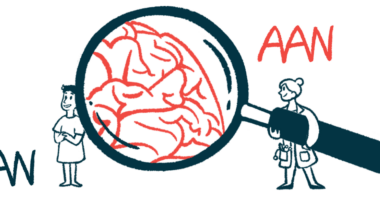#AANAM – Uplizna Found to Prevent Pain Worsening in Patients

Uplizna (inebilizumab-cdon) reduced pain among adults with neuromyelitis optica spectrum disorder (NMOSD), according to an analysis of the N-MOmentum Phase 2/3 clinical trial.
The results were presented by Ho Jin Kim, MD, PhD, an investigator in the trial, at the 2021 virtual American Academy of Neurology Annual Meeting, running April 17–22. The poster was titled “Inebilizumab Treatment Reduces The Occurrence Of Pain In NMOSD Patients.”
NMOSD is an autoimmune disease in which the immune system wrongly produces antibodies that attack astrocytes and oligodendrocytes — cells that support the nervous system — and cause inflammation in the optic nerve and spinal cord.
This is often associated with pain inside the eye, uncomfortable burning or tingling, or painful involuntary muscle contractions, which have a considerable impact on a patient’s quality of life.
Uplizna, developed by Viela Bio, reduces inflammation by targeting B-cells — the immune cells that make the antibodies found in NMOSD patients — and leading to their death, thereby reducing the risk of NMOSD attacks.
The therapy was approved last year as a twice-a-year treatment for NMOSD patients with high levels of antibodies against the protein aquaporin-4 (AQP4). Its approval was based on data from the N-MOmentum trial (NCT02200770), which evaluated Uplizna’s safety and efficacy in 230 adults with NMOSD.
Participants received Uplizna or a placebo on the first day of treatment and again on day 15. The treatment period lasted for 28 weeks (approximately seven months), after which patients could enter a long-term, open-label extension period and receive Uplizna every six months for at least two years.
In the randomized part, Uplizna treatment resulted in a 72.8% lower risk of attacks, compared with a placebo. These benefits were long-lasting, as 80% of patients who ever received a dose of Uplizna during the trial or its extension remained attack-free after four years.
The latest data analysis now focused on treatment-related experiences of pain, during the initial treatment period.
A total of 213 participants — 161 receiving Uplizna and 52 on a placebo — rated their pain every four weeks on an 11-point Pain Numeric Rating Scale (NRS-11), that covered the eyes, arms, legs, upper back, and lower back.
At baseline, or the start of the study, 22% of patients reported feeling severe pain (NRS-11 of seven or more), 47% reported moderate pain (NRS-11 of four to six), and 31% reported mild pain (NRS-11 of two or less).
Pain scores were similar across both treatment and placebo groups at this point, but Uplizna treatment correlated with less pain throughout the study.
Overall, 35 participants experienced confirmed NMOSD attacks during the treatment period. Of these, 22 (63%) reported a worsening of at least three points on the NRS-11, in at least one body area. This three-point worsening persisted through the following visit among 36% of these individuals.
More than half of patients (56%, 90 of 162) without a confirmed attack also experienced a total of 389 episodes in which their pain scores worsened by three or more points. This heightened perception of pain persisted for more than one visit among 35% of these participants.
These pain increases occurred more often in placebo-treated patients than among those given Uplizna (77% vs 56%), independent of a worsening of NMOSD symptoms. Furthermore, more individuals taking Uplizna reported being free of severe pain during treatment than those on placebo (59% vs 38%).
Rates were similar, however, for those reporting both moderate (19% vs. 25%) and severe chronic pain (6.2% vs. 1.9%) at every assessment.
Finally, the investigators running the trial also measured pain using a separate scale, the SF-36, which includes several other health and quality-of-life measurements.
While pain scores on this scale generally improved from baseline through the open-label period, the improvement did not reach significance for the overall population in the Uplizna group.
But the treatment did result in a significant improvement in SF-36 pain scores in a population who started the trial with worse pain scores (under 40 out of 100, where higher scores indicate less disability). This improvement was sustained throughout at least two years during the extension study.
“Further investigation is required to investigate the mechanisms underlying the development of acute pain vs. chronic pain experienced by NMOSD patients,” the team concluded.






